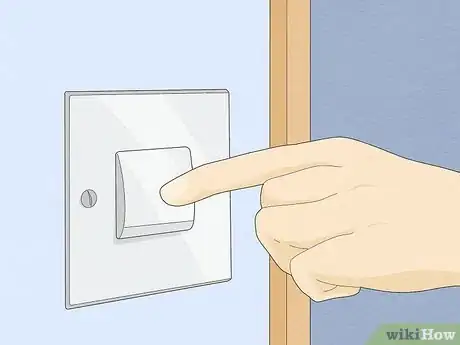This article was co-authored by Corey Fish, MD. Dr. Corey Fish is a practicing Pediatrician and the Chief Medical Officer at Brave Care, a pediatric healthcare company based in Portland, Oregon. Dr. Fish has over 10 years of experience in pediatric care and is a member of the American Academy of Pediatrics. Dr. Fish received a BS in Biology from Pacific Lutheran University in 2005, an MD from the University of Washington School of Medicine in 2009, and completed his Pediatric Residency at the University of Texas Southwestern Medical School in 2012.
There are 8 references cited in this article, which can be found at the bottom of the page.
This article has been viewed 69,227 times.
While caring for a newborn, a good night’s sleep quickly becomes a distant memory. However, between 3 and 6 months, your baby is capable of sleeping for 5 hour stretches, and after 6 months, your baby can sleep for 10 hour stretches.[1] Although you will have to establish a bedtime routine for your baby to help them sleep long and well, it is worth the effort! With a little patience and practice, your baby can sleep through the night, and you can, too.
Steps
Establishing a Good Bedtime Routine
-
1Start the bedtime routine at the same time each night. Consistency is key when teaching your baby good sleep habits. Put your baby to bed at about the same time every night. This will help your baby to associate sleep with a specific time of night and make the process easier for both of you.[2] [3]
- For example, you might put your baby to bed at 7:30pm each night. Don’t change their bedtime on certain days of the week. Keep it the same every day, including the weekend.
Tip: Make sure to be consistent with wake-up time and nap times as well. If your baby wakes in the morning and takes naps at random times, then they might find it hard to go to bed at the same time each night.
-
2Give your baby a bath and put on their pajamas. Something as simple as giving your baby a bath and getting them into their pajamas can help them to understand that it is time to go to sleep. Do this at the beginning of your baby’s bedtime routine so that they will associate these activities with winding down.[4]
- Use calming bath products, such as a lavender scented soap and lotion.
- You could also give your baby a soothing massage with baby lotion after their bath.
- Dress your baby in pajamas that are appropriate for the season, such as warm fleece pajamas in winter or lightweight cotton pajamas during the summer.
Advertisement -
3Dim the lights and ensure that the room is quiet. After your baby is in their pajamas, don’t take them out of the bedroom or do anything to stir them up. Dim the lights, turn on a night light, and play some soft music to help your baby calm down. Ask other household members to keep quiet during your baby’s bedtime routine since noises in the hallway or in other rooms may disturb your baby.[5] [6]
- After your baby is in their pajamas, avoid letting them play with stimulating toys or playing games with them.
- Keep your voice low and calm when you speak to them and don’t talk too much.
- Consider using a white noise machine.[7]
-
4Read a bedtime story and sing a lullaby. Another way to start calming your baby down for bedtime is to read them a story and sing a calming lullaby while you hold them. Make this a standard part of your baby’s bedtime routine. Over time, your baby will begin to associate these activities with sleep.[8]
- For example, you could read your baby Goodnight Moon and sing “Twinkle Twinkle Little Star” every night to help them get sleepy.
-
5Put your baby in their crib while they are drowsy but awake. While it can be tempting to rock and cuddle your baby to sleep each night, this may lead to sleep issues later on. Your baby will start to depend on you to fall asleep, and they may have trouble falling asleep again if they wake up in the night. Instead, wait until your baby seems drowsy and close to falling asleep, and then place them into their crib.[9]
- Always place your baby in their crib on their back! This decreases the risk of Sudden Infant Death Syndrome (SIDS). When your baby is able to roll over on their own, they will adjust their position in bed to get comfortable.
Dealing with Nighttime Wakings
-
1Speak softly and keep the lights turned down low if your baby wakes up. Even after your baby is capable of sleeping through the night, your baby may still wake up sometimes in the middle of the night. When they do, make sure to speak in a calm, low voice while you change them, comfort them, etc. This will help you to avoid stimulating your baby too much and make it easier to get them sleeping again.[10]
- If your baby needs to be fed during the night, avoid playing or talking too much as you feed them.
- Only go to your baby if they're truly crying. If they're just fussing, grunting, or whining, they may fall asleep again on their own.[11]
Tip: Babies often wake up during the night because they need a diaper change, they are thirsty or hungry, or they are seeking comfort. Check your baby’s diaper, offer breastmilk or a bottle of formula, and cuddle your baby to comfort them.[12]
-
2Offer your baby a pacifier to help soothe them.[13] A pacifier may satisfy your baby’s urge to suckle and keep them asleep for longer stretches. It can also help to soothe your baby to sleep after you put them into their crib. Give your baby a pacifier before you lay them down for the night and help them find it again if they wake up.[14]
- Allowing your baby to suck on a pacifier while they sleep can also help to reduce the risk of SIDS.
-
3Try swaddling your baby to help them feel secure. Place an open blanket onto a flat, sturdy surface, such as a bed, and fold over 1 corner of the blanket. Place your baby onto the blanket with their head on the folded corner. Wrap 1 corner of the blanket over your baby's body so that it covers their arm. Then, bring the bottom of the blanket up and over the baby's feet. Wrap the third side across the baby's other arm and tuck it under them.[15] [16]
- You can also purchase special swaddle-wrap sleep sacks to help keep your baby warm and comforted.
- Keep in mind that swaddling is typically used for newborns, so this might not be as helpful for a baby older than 3 months.
-
4Place your baby back into their crib after taking care of their needs. Once you have changed, fed, and/or comforted your baby, place them right back into their crib. Remember to lay your baby on their back! Don’t try to rock your baby to sleep or hold them until they fall asleep as this may cause them to rely on you doing this in the future.[17]
- Avoid placing your baby in bed with you until they fall asleep. While this may work sometimes, it can teach your baby to dislike being in their crib and there is also a risk of your baby suffocating, so it’s best to avoid doing this.[18]
Trying the Ferber Method of Sleep Training
-
1Place your baby in their crib after their bedtime routine. The Ferber Method is compatible with any bedtime routine, so you won't have to change what has been working for your baby. The only difference is in how you respond to your baby after they are in bed. Go through your usual routine with your baby. Then, once your baby is drowsy and ready for sleep, place them into their crib.[19]
Warning: Don’t attempt to sleep train your baby until they are at least 4 months old. Babies younger than 4 months cannot sleep through the night because they need to feed during the night. However, once your baby is 4 months, they should be able to sleep for 6 hours stretches without eating.
-
2Leave the room and allow them to cry for 5 minutes. After you have placed your baby on their back, exit the room. Your baby may cry, but this is normal. Allow your baby to cry for up to 5 minutes before returning to the room again.[20]
- You can listen just outside the door or use a baby monitor.
-
3Return to the room after 5 minutes and give your baby a reassuring pat. After 5 minutes have passed, come back into your baby’s room and give your baby a reassuring pat and tell them everything is okay.[21]
- Try saying something like, “You’re okay! Mommy loves you!” or “Go back to sleep, sweetie. I love you!”
-
4Leave for 10 minutes and then come back to reassure your baby again. After reassuring your baby, leave the room again and this time do not return for 10 minutes. Your baby may continue crying for the full 10 minutes or they may tire themself out and fall asleep. Either way, wait for 10 minutes before you return to the room, and then reassure your baby in the same way as before.[22]
- This can be difficult for many parents to do since listening to your baby cry can be heartbreaking. However, it is a necessary part of the process.
-
5Continue to increase the time by 5 minutes each time you leave the room. The goal is to gradually increase the time by 5 minutes after each visit to your baby’s room to reassure them. At a certain point, your baby should fall asleep on their own. Repeat the process every night and your baby should fall asleep faster after a few nights of using this technique.[23]
- Keep in mind that this method is controversial. Some parents think it is too extreme and prefer variations where they stay in the room while their baby cries or where they wait until the baby’s natural bedtime—no matter how late it is—and then put the baby to bed when they seem truly sleepy. If this technique does not work for you and your baby, then try something else.
Expert Q&A
Did you know you can get expert answers for this article?
Unlock expert answers by supporting wikiHow
-
QuestionIs screentime bad for babies?
 Corey Fish, MDDr. Corey Fish is a practicing Pediatrician and the Chief Medical Officer at Brave Care, a pediatric healthcare company based in Portland, Oregon. Dr. Fish has over 10 years of experience in pediatric care and is a member of the American Academy of Pediatrics. Dr. Fish received a BS in Biology from Pacific Lutheran University in 2005, an MD from the University of Washington School of Medicine in 2009, and completed his Pediatric Residency at the University of Texas Southwestern Medical School in 2012.
Corey Fish, MDDr. Corey Fish is a practicing Pediatrician and the Chief Medical Officer at Brave Care, a pediatric healthcare company based in Portland, Oregon. Dr. Fish has over 10 years of experience in pediatric care and is a member of the American Academy of Pediatrics. Dr. Fish received a BS in Biology from Pacific Lutheran University in 2005, an MD from the University of Washington School of Medicine in 2009, and completed his Pediatric Residency at the University of Texas Southwestern Medical School in 2012.
Pediatrician & Chief Medical Officer, BraveCare
-
QuestionHow do I transition my baby to sleep in her crib on her own?
 Julie Wright, MFTJulie Wright is a Marriage and Family Therapist and the co-founder of The Happy Sleeper, which offers sleep consulting and online baby sleep classes. Julie is a licensed psychotherapist specializing in babies, children, and their parents, and the co-author of two best selling parenting books (The Happy Sleeper and Now Say This) published by Penguin Random House. She created the popular Wright Mommy, Daddy and Me program in Los Angeles, California, which provides support and learning for new parents. Julie's work has been mentioned in The New York Times, The Washington Post, and NPR. Julie received her training at the Cedars Sinai Early Childhood Center.
Julie Wright, MFTJulie Wright is a Marriage and Family Therapist and the co-founder of The Happy Sleeper, which offers sleep consulting and online baby sleep classes. Julie is a licensed psychotherapist specializing in babies, children, and their parents, and the co-author of two best selling parenting books (The Happy Sleeper and Now Say This) published by Penguin Random House. She created the popular Wright Mommy, Daddy and Me program in Los Angeles, California, which provides support and learning for new parents. Julie's work has been mentioned in The New York Times, The Washington Post, and NPR. Julie received her training at the Cedars Sinai Early Childhood Center.
Parenting & Baby Sleep Specialist Anytime you're transitioning your child, it helps to give them a little bit of playtime in the new environment. So whether it's just a different crib, a crib that's in your room, or if you're moving them into their own room, we always say dress it for play and spend some time in there when your baby's happy and fed and rested. You can sing to them or talk to them, or they can just watch the trees move by. We want them to have positive associations, and we want them to become familiar with what it feels like to be in that crib.
Anytime you're transitioning your child, it helps to give them a little bit of playtime in the new environment. So whether it's just a different crib, a crib that's in your room, or if you're moving them into their own room, we always say dress it for play and spend some time in there when your baby's happy and fed and rested. You can sing to them or talk to them, or they can just watch the trees move by. We want them to have positive associations, and we want them to become familiar with what it feels like to be in that crib. -
QuestionHow can I help my newborn sleep when he has an ear infection?
 Julie Wright, MFTJulie Wright is a Marriage and Family Therapist and the co-founder of The Happy Sleeper, which offers sleep consulting and online baby sleep classes. Julie is a licensed psychotherapist specializing in babies, children, and their parents, and the co-author of two best selling parenting books (The Happy Sleeper and Now Say This) published by Penguin Random House. She created the popular Wright Mommy, Daddy and Me program in Los Angeles, California, which provides support and learning for new parents. Julie's work has been mentioned in The New York Times, The Washington Post, and NPR. Julie received her training at the Cedars Sinai Early Childhood Center.
Julie Wright, MFTJulie Wright is a Marriage and Family Therapist and the co-founder of The Happy Sleeper, which offers sleep consulting and online baby sleep classes. Julie is a licensed psychotherapist specializing in babies, children, and their parents, and the co-author of two best selling parenting books (The Happy Sleeper and Now Say This) published by Penguin Random House. She created the popular Wright Mommy, Daddy and Me program in Los Angeles, California, which provides support and learning for new parents. Julie's work has been mentioned in The New York Times, The Washington Post, and NPR. Julie received her training at the Cedars Sinai Early Childhood Center.
Parenting & Baby Sleep Specialist First of all, you always want to tend to your child. Suspend any of your usual sleep approaches during that time and make sure that you do everything that you can to help your baby feel comfortable. That depends on your individual comfort with using some kind of infant pain medication or something more holistic. Some people suggest putting something warm on the ear, making sure it's not too warm, to help relieve pain from an ear infection. I'm sure that pediatricians can give them some suggestions, but you definitely want your baby to be soothed and comforted during the night.
First of all, you always want to tend to your child. Suspend any of your usual sleep approaches during that time and make sure that you do everything that you can to help your baby feel comfortable. That depends on your individual comfort with using some kind of infant pain medication or something more holistic. Some people suggest putting something warm on the ear, making sure it's not too warm, to help relieve pain from an ear infection. I'm sure that pediatricians can give them some suggestions, but you definitely want your baby to be soothed and comforted during the night.
References
- ↑ https://www.sleepfoundation.org/articles/when-do-babies-sleep-through-night
- ↑ Corey Fish, MD. Pediatrician & Chief Medical Officer, BraveCare. Expert Interview. 17 March 2020.
- ↑ https://www.mayoclinic.org/healthy-lifestyle/infant-and-toddler-health/in-depth/baby-sleep/art-20045014
- ↑ https://www.mayoclinic.org/healthy-lifestyle/infant-and-toddler-health/in-depth/baby-sleep/art-20045014
- ↑ Corey Fish, MD. Pediatrician & Chief Medical Officer, BraveCare. Expert Interview. 17 March 2020.
- ↑ https://www.mayoclinic.org/healthy-lifestyle/infant-and-toddler-health/in-depth/baby-sleep/art-20045014
- ↑ Corey Fish, MD. Pediatrician & Chief Medical Officer, BraveCare. Expert Interview. 17 March 2020.
- ↑ https://www.mayoclinic.org/healthy-lifestyle/infant-and-toddler-health/in-depth/baby-sleep/art-20045014
- ↑ https://www.mayoclinic.org/healthy-lifestyle/infant-and-toddler-health/in-depth/baby-sleep/art-20045014
- ↑ https://www.mayoclinic.org/healthy-lifestyle/infant-and-toddler-health/in-depth/baby-sleep/art-20045014
- ↑ Julie Wright, MFT. Parenting & Baby Sleep Specialist. Expert Interview. 6 March 2020.
- ↑ https://www.babycentre.co.uk/a123/how-can-i-get-my-baby-to-sleep-through-the-night
- ↑ Julie Wright, MFT. Parenting & Baby Sleep Specialist. Expert Interview. 6 March 2020.
- ↑ https://www.mayoclinic.org/healthy-lifestyle/infant-and-toddler-health/in-depth/baby-sleep/art-20045014
- ↑ Corey Fish, MD. Pediatrician & Chief Medical Officer, BraveCare. Expert Interview. 17 March 2020.
- ↑ https://www.mayoclinic.org/healthy-lifestyle/infant-and-toddler-health/multimedia/how-to-swaddle-a-baby/sls-20076006
- ↑ https://www.babycentre.co.uk/a123/how-can-i-get-my-baby-to-sleep-through-the-night
- ↑ https://www.babycentre.co.uk/a123/how-can-i-get-my-baby-to-sleep-through-the-night
- ↑ https://www.parents.com/baby/sleep/issues/getting-baby-to-sleep-through-the-night/
- ↑ https://www.parents.com/baby/sleep/issues/getting-baby-to-sleep-through-the-night/
- ↑ https://www.parents.com/baby/sleep/issues/getting-baby-to-sleep-through-the-night/
- ↑ https://www.parents.com/baby/sleep/issues/getting-baby-to-sleep-through-the-night/
- ↑ https://www.parents.com/baby/sleep/issues/getting-baby-to-sleep-through-the-night/
- ↑ https://www.health.harvard.edu/blog/getting-your-baby-to-sleep-through-the-night-the-good-and-maybe-not-so-good-news-2018111915411
About This Article
To get your baby to sleep through the night, start by establishing a nighttime routine and sticking to it consistently. For example, giving your baby a bath and putting on their pajamas at the same time each night can help them understand that it's time to go to sleep. Keep the lights dim and speak in a soft voice as you put them into their crib. If your baby uses a pacifier, let them suck on it as they fall asleep to soothe them. For tips on what to do when your baby wakes up in the night, read on!










































































